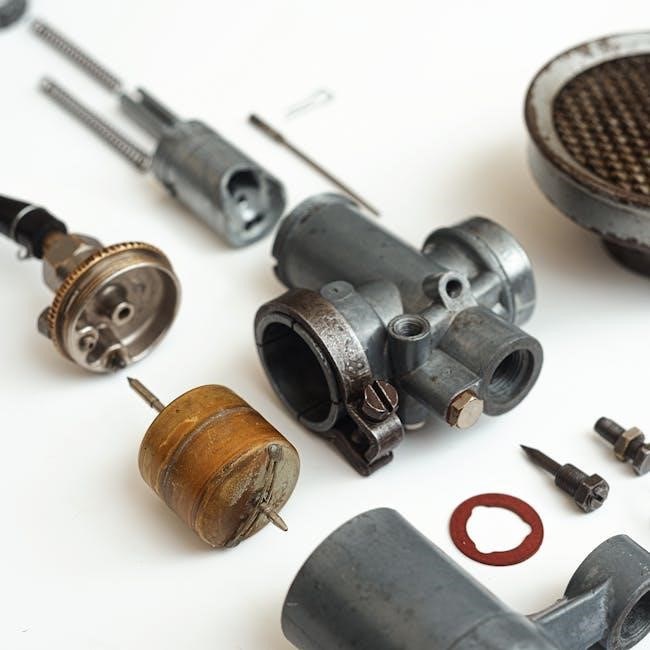Welcome to the comprehensive guide on GE washing machine repair manuals. These manuals provide detailed instructions, troubleshooting guides, and parts lists for diagnosing and fixing issues. They are essential for ensuring safety, understanding components, and performing effective repairs on your appliance.
Overview of GE Washing Machine Models
GE offers a wide range of washing machine models, including top-loading, front-loading, and high-efficiency designs. Popular models like the GTW465ASN2WW and GUD27ESSMWW are known for their durability and advanced features. These models often include unitized laundry centers, combining washers and dryers for convenience. Repair manuals for these appliances provide detailed specifications, diagrams, and troubleshooting guides tailored to each model. Understanding your specific model is crucial for effective repairs and maintaining optimal performance. These manuals ensure you have the right information to address any issue;
Importance of Using Official Repair Manuals
Official GE washing machine repair manuals are crucial for safe and effective repairs. They provide accurate diagrams, wiring details, and step-by-step instructions tailored to specific models. These manuals ensure compliance with safety standards and prevent improper servicing, which could void warranties or cause hazards. By following official guidelines, users can diagnose and fix issues confidently, maintaining their appliance’s performance and longevity. Always refer to authorized manuals to guarantee reliable and secure repairs.
Where to Find GE Washing Machine Repair Manuals
Official GE washing machine repair manuals can be sourced from various trusted platforms. The GE Appliances official website allows users to search by model number to access specific manuals. Additionally, websites like RepairClinic.com and ManualsLib.com offer comprehensive repair guides and diagrams. Authorized retailers and service centers also provide access to genuine manuals. Always ensure to download from reputable sources to guarantee accuracy and safety for your appliance repairs.

Safety Precautions for Repairing GE Washing Machines
Always disconnect power before starting repairs. Wear protective gear and avoid hot surfaces. Follow manual instructions carefully and never attempt unauthorized repairs to ensure safety and prevent damage.
Electrical Safety Measures
Always disconnect the washing machine from the power supply before starting repairs. Verify that no voltage is present using a multimeter. Use insulated tools to prevent electric shocks. Avoid working on the machine in damp environments, as moisture increases the risk of electrical hazards. Never touch internal components without ensuring the appliance is grounded. Be cautious of high-voltage parts, such as capacitors, which may retain charge even when the power is off. If unsure, consult a licensed electrician to ensure safe repair practices.
Proper Use of Tools and Equipment
Use appropriate tools for repair to avoid damaging the washing machine. Screwdrivers, wrenches, and pliers are essential for disassembling components. Ensure tools are in good condition to prevent slips or accidents. For electrical work, use insulated tools to minimize shock risks. Always refer to the manual for specific tool recommendations. Keep tools organized and within reach to streamline the repair process. Avoid using improvised or substandard tools, as they may damage the appliance or compromise safety. Proper tool usage ensures efficient and effective repairs.
Understanding Safety Warnings in Manuals
GE washing machine repair manuals include critical safety warnings to protect users during repairs. These warnings highlight potential hazards, such as electrical shocks or injuries from moving parts. They emphasize proper grounding, disconnecting power before starting work, and avoiding unsafe practices. Adhering to these guidelines ensures personal safety and prevents damage to the appliance. Always read and follow the safety warnings carefully to maintain a secure repair environment. These precautions are designed to safeguard both the user and the machine, making them indispensable for successful repairs.

Common Issues in GE Washing Machines
Common issues in GE washing machines include not turning on, not spinning, or not draining. Noise and vibration problems also frequently occur, requiring prompt attention often.
Washing Machine Not Turning On
If your GE washing machine fails to turn on, check the power supply first. Ensure the plug is securely connected and the circuit breaker hasn’t tripped. Verify the lid switch is functioning, as an open lid can prevent operation. Inspect the power cord for damage and test the outlet. If issues persist, internal components like the control board or motor might need professional attention. Always consult the repair manual for specific diagnostic steps and safety precautions before attempting any fixes.
Washing Machine Not Spinning
If your GE washing machine isn’t spinning, check for an unbalanced load or excess weight. Ensure the lid is closed properly and the lid switch is functioning. Verify the drain pump is clear of blockages, as a clogged drain can prevent spinning. Inspect the belt and pulley system for wear or damage; Consult the repair manual for specific troubleshooting steps, such as checking error codes or testing the motor control board. Addressing these issues promptly can restore proper spin function and ensure efficient washing cycles.
Washing Machine Not Draining
If your GE washing machine isn’t draining, check for blockages in the drain pump filter or hoses. Ensure the drain hose is properly connected and not kinked. Consult the repair manual for guidance on accessing and cleaning the pump. If issues persist, inspect the drain motor or impeller for damage. Regular maintenance, such as cleaning the filter and ensuring proper installation, can prevent drainage problems. Refer to the troubleshooting section of your manual for detailed steps to restore proper drainage functionality.
Noise and Vibration Issues
If your GE washing machine is producing excessive noise or vibration, check for imbalanced loads or loose mounting screws. Ensure the machine is level and stable. Worn-out bearings, a faulty belt, or a malfunctioning motor could also cause noise. Refer to your repair manual for diagnostic steps. Inspect the tub bearings and balance ring for damage. For severe issues, consult model-specific manuals or online resources like RepairClinic.com for detailed repair guides and video instructions to address the problem effectively.
Troubleshooting Steps for GE Washing Machines
Identify symptoms, use diagnostic modes, and check error codes. Refer to the service manual for guidance. Inspect electrical connections and drainage systems. Consult online resources like RepairClinic.com for detailed repair guides and video instructions to address common issues effectively.
Using Diagnostic Modes
Modern GE washing machines feature diagnostic modes to help identify issues. Activate this mode by pressing and holding specific buttons, such as Spin and Soil, for 3-5 seconds. The machine will display error codes or flash lights to indicate problems. Refer to the service manual to interpret these codes. Diagnostic modes allow you to troubleshoot issues like faulty sensors or electrical malfunctions. Use this feature to pinpoint problems before attempting repairs. Always consult the official manual for guidance on using diagnostic modes effectively.
Understanding Error Codes
GE washing machines display error codes like E1, E2, or PF to indicate specific issues. These codes help diagnose problems quickly. For example, E1 often refers to a lid lock failure, while E2 may signal a water supply issue. Always reference the repair manual to match codes with their meanings. Once identified, follow the manual’s guidance to address the problem, such as checking electrical connections or replacing faulty components. This step is crucial for effective troubleshooting and repair. Use the manual to ensure accurate interpretations and solutions.
Checking Electrical Connections
Checking electrical connections is crucial for diagnosing issues with your GE washing machine. Start by ensuring the power cord is securely plugged into a functioning outlet. Verify that the circuit breaker or fuse hasn’t tripped or blown. If the machine still doesn’t power on, inspect the electrical connections inside, such as the lid lock and door switch. Consult the repair manual for wiring diagrams to identify potential loose or faulty connections. Proper electrical checks can resolve many power-related issues quickly and safely.
Inspecting Drain Pumps and Hoses
Inspecting the drain pump and hoses is essential for resolving drainage issues in your GE washing machine. Start by locating the drain pump filter, usually at the bottom of the machine, and clean it thoroughly. Check the drain hoses for kinks, blockages, or damage. Ensure the hose is properly secured to both the machine and the drain pipe. If you find debris or obstructions, remove them to restore proper water flow. Refer to your repair manual for specific instructions on accessing and inspecting these components safely and effectively.

Role of the User Manual in Repair
The user manual serves as a crucial guide for troubleshooting and understanding your GE washing machine, offering detailed instructions for repairs and maintenance.
How to Use the User Manual for Troubleshooting
Using the user manual for troubleshooting involves identifying the issue, locating the relevant section, and following step-by-step instructions. Start by describing the problem in the manual’s troubleshooting guide. If error codes appear, refer to the code list for solutions. Verify electrical connections and inspect components as instructed. Always follow safety precautions outlined in the manual. By systematically addressing each symptom, you can diagnose and resolve common issues efficiently, ensuring your GE washing machine operates smoothly.
Understanding the User Manual Layout
The user manual for your GE washing machine is organized to help you navigate easily. It typically starts with an index or table of contents, followed by sections on installation, operation, and troubleshooting. Diagrams and illustrations are included to clarify complex procedures. The manual also lists error codes with explanations and solutions. Familiarize yourself with these sections to quickly locate information and address issues efficiently. Understanding the layout ensures you can use the manual effectively for repairs and maintenance.
Key Sections of the User Manual
The user manual for your GE washing machine includes essential sections to guide you through repair and maintenance. Key areas include the index/table of contents, installation instructions, operating guidelines, and safety precautions. The troubleshooting section helps identify common issues, while wiring diagrams and component access information aid in repairs. Additionally, the manual lists error codes with explanations and solutions, ensuring you can address problems effectively. Familiarize yourself with these sections to maximize the manual’s utility for your appliance.

GE Washing Machine Repair Manuals
GE washing machine repair manuals are comprehensive guides offering troubleshooting, error codes, and component access. Available in PDF, they cover general and model-specific repairs, ensuring effective fixes.
General Repair Manual Overview
A general repair manual for GE washing machines provides a broad overview of common issues and solutions. It includes troubleshooting guides, diagnostic tips, and step-by-step repair instructions. These manuals cover essential components like motors, pumps, and control boards, offering a foundational understanding for both novice and experienced technicians. They often feature wiring diagrams and safety precautions to ensure repairs are performed correctly and safely. This makes them a valuable resource for anyone looking to maintain or fix their GE appliance effectively.
Model-Specific Repair Manuals
Model-specific repair manuals are tailored to individual GE washing machine models, offering precise instructions and diagrams. These manuals are crucial for complex repairs, as they provide exact part numbers and troubleshooting steps unique to each model. For example, the GE GTW465ASN2WW manual includes detailed wiring diagrams and component access guides. They are available on the GE Appliances website and platforms like RepairClinic.com, often in downloadable PDF format, ensuring accessibility for technicians and DIYers alike.
Downloading Repair Manuals in PDF Format
GE washing machine repair manuals are conveniently available for download in PDF format from various sources. The GE Appliances official website allows users to enter their model number and access corresponding manuals. Additionally, platforms like RepairClinic.com and other appliance repair websites offer free downloadable PDF versions. These manuals are searchable by model number, ensuring you find the exact guide for your unit. PDF formats provide easy access, printing options, and offline use, making them indispensable for repairs and maintenance tasks.

Parts and Supplies for GE Washing Machine Repair
For effective GE washing machine repair, genuine parts and essential tools are crucial. Ensure you source components from authorized dealers or GE’s official website for compatibility and quality. Always refer to your repair manual for specific part numbers and requirements to avoid mismatches and ensure safe, efficient repairs. Proper tools and supplies are vital for successful DIY fixes and professional servicing. Stocking common replacement parts can also save time during maintenance.
Where to Buy Genuine GE Parts
Genuine GE parts can be purchased directly from the GE Appliances official website or through authorized distributors. Sears Parts Direct and RepairClinic.com are trusted sources for genuine components. Additionally, GE’s customer service hotline (1-800-432-2737) can assist in locating parts. Always verify the authenticity of parts to ensure compatibility and safety; Using genuine parts guarantees optimal performance and extends the lifespan of your washing machine. For model-specific parts, refer to your repair manual or contact GE’s parts center for accurate recommendations.
Essential Tools for Repair
For effective GE washing machine repair, gather essential tools like screwdrivers (Phillips and Torx), pliers, wrenches, and multimeters. A socket set is handy for accessing internal components. Safety gear, such as gloves and goggles, is crucial for protection. Ensure tools are compatible with your machine’s fasteners to avoid damage. Refer to the repair manual for specific tools needed for your model. Using the right tools ensures efficient and safe repairs, minimizing risks and prolonging the appliance’s lifespan.
Common Replacement Parts
Common replacement parts for GE washing machines include the drain pump, water inlet valves, shock absorbers, and belts. The drain pump often fails due to blockages or wear. Water inlet valves may need replacement if leaks occur. Shock absorbers can wear out, causing vibration issues. Belts may crack or break over time. Regularly inspecting these components can prevent major repairs. Always consult the repair manual for model-specific parts and ensure genuine GE replacements are used for optimal performance and longevity.

Advanced Repair Techniques
Advanced techniques involve disassembling the washing machine, replacing complex components like motors and control boards, and fixing internal systems such as water pumps and valves.
Disassembling the Washing Machine
Disassembling a GE washing machine requires careful planning and tools like screwdrivers and wrenches. Always unplug the machine and disconnect water hoses for safety. Start by removing the top panel or lid, followed by the control panel and tub. Gently pull out the inner tub and inspect the motor, belts, and pumps. Refer to the repair manual for specific instructions, as procedures vary by model. Ensure all electrical connections are disconnected before accessing internal components. This step is crucial for diagnosing and repairing complex issues effectively.
Replacing the Motor and Control Board
Replacing the motor and control board in a GE washing machine is a complex task that requires precision. Start by disconnecting power and water supplies for safety. Access the motor by removing the tub and belts, then detach electrical connectors and mounting hardware. Install the new motor, ensuring proper alignment and secure fastening. For the control board, disconnect sensors and wiring, remove the old board, and install the new one; Follow the repair manual’s instructions for reconnecting components and testing the system to ensure proper function.
Fixing the Water Pump and Valve
Fixing the water pump and valve in your GE washing machine involves diagnosing leaks or blockages. Start by accessing the pump, typically located at the bottom, and inspect for debris or damage. Clean or replace the pump filter if clogged. If the pump is faulty, disconnect hoses and electrical connections, then install a new one. For the valve, check for proper water flow and replace it if damaged. Always refer to your repair manual for specific instructions and ensure all water supplies are turned off before starting repairs.

Online Resources for GE Washing Machine Repair
Access RepairClinic.com for detailed guides, videos, and parts. Visit GE Appliances’ official website for manuals and support. Explore forums for community advice and troubleshooting tips.
RepairClinic.com Guides and Videos
RepairClinic.com offers extensive resources for repairing GE washing machines, including detailed repair guides, instructional videos, and parts diagrams. Their database provides specific information for various GE models, helping users identify and fix issues efficiently. The platform also features a 24/7 customer support line for additional assistance. By utilizing these resources, users can diagnose problems, understand repair procedures, and order genuine parts directly, making it a one-stop solution for DIY repairs and maintenance;
GE Appliances Official Support Website
The official GE Appliances support website is a trusted source for repair manuals, troubleshooting guides, and technical specifications. Users can enter their model number to access specific documentation, including PDF repair manuals and user guides. The site also offers installation instructions, energy guides, and a parts lookup tool. Additionally, it provides contact information for customer service and authorized service centers, ensuring comprehensive support for all GE washing machine repair needs.
Forums and Community Discussions
Online forums and community discussions are valuable resources for troubleshooting and repairing GE washing machines. Websites like RepairClinic.com host forums where users share repair experiences and solutions. These platforms allow you to ask questions, receive advice, and access model-specific repair tips. Many discussions focus on common issues such as error codes, noises, or drainage problems. Additionally, some forums provide links to repair manuals and diagnostic tools, making them a helpful supplement to official resources for DIY repairs and maintenance.

Contacting GE Appliance Support
For assistance, contact GE Appliances at 1-800-432-2737 (Monday-Friday, 8 a.m.-8 p.m. ET). Support is also available online via live chat or email for inquiries and repairs.
GE Customer Service Contact Information
GE Appliances provides dedicated customer support for repair inquiries. Contact their team at 1-800-432-2737, available Monday through Friday from 8 a.m. to 8 p.m. ET. For online assistance, visit their official website at geappliances.com. Additional resources, such as service manuals and troubleshooting guides, are accessible through their support page. Representatives are ready to help with parts, repair scheduling, and technical advice to ensure your washing machine operates efficiently.
Scheduling a Professional Repair Service
To schedule a professional repair service for your GE washing machine, visit the official GE Appliances website or call 1-800-432-2737. Provide your appliance’s model number for accurate service. Representatives are available Monday through Friday, 8 a.m. to 8 p.m. ET. GE authorized service centers ensure repairs are done with genuine parts and expert technicians. This service guarantees your washing machine is restored to optimal performance, adhering to manufacturer standards and warranty terms for a reliable and long-lasting solution.
Authorized Service Centers
GE Appliances operates a network of authorized service centers across the country. These centers employ certified technicians trained to repair GE washing machines using genuine parts. To locate an authorized service center, visit the official GE Appliances website and enter your zip code. You can also call 1-800-432-2737 for assistance. Authorized centers ensure repairs meet manufacturer standards, maintain warranty validity, and provide reliable, long-term solutions for your appliance. Trusting authorized centers guarantees quality and safety for your GE washing machine repair needs.

Preventative Maintenance Tips
Regular cleaning and checks can prevent major issues. Ensure proper ventilation, clean the gasket, and check hoses for damage. Regular maintenance extends your washing machine’s lifespan.
Regular Cleaning and Checks
Regular cleaning and routine checks are crucial for maintaining your GE washing machine’s performance. Start by running a cleaning cycle with a washing machine cleaner or vinegar to remove residue. Inspect and clean the gasket and detergent dispenser monthly to prevent mold buildup. Check hoses for signs of wear, cracks, or kinks, and replace them every 5 years. Ensure the drain pump filter is cleaned regularly to avoid clogs. These simple steps can prevent costly repairs and extend the lifespan of your appliance.
Maintaining Proper Ventilation
Maintaining proper ventilation is essential for your GE washing machine’s efficiency and longevity. Ensure the washer is installed in a well-ventilated area, at least 4 inches away from walls to promote airflow. Avoid placing items on top of the machine, as this can block ventilation openings. Regularly inspect and clean the venting system to prevent lint buildup. This helps reduce moisture, prevents mold growth, and minimizes odors. Proper ventilation also ensures optimal drying performance and prevents overheating, which can damage the machine over time.
Ensuring Proper Installation
Proper installation is crucial for the optimal performance and longevity of your GE washing machine. Ensure the machine is placed on a level, stable surface to prevent vibration and imbalance. Follow the manufacturer’s guidelines for connecting water supply lines, ensuring they are securely attached to avoid leaks. Check the drain hose installation to confirm it is correctly positioned and not kinked. Refer to the user manual for specific model requirements, as improper installation can lead to operational issues or damage. Proper setup ensures safety, efficiency, and reliable performance. Always adhere to the manufacturer’s instructions for a hassle-free experience.
This concludes the GE Washing Machine Repair Manual. Always prioritize safety, efficiency, and proper maintenance. Follow guidelines carefully and refer to official resources for further assistance.
Final Tips for Successful Repair
Always refer to the official GE repair manual for specific instructions. Ensure safety by unplugging the machine before starting repairs. Test the washer after fixing to confirm the issue is resolved. Keep all screws and parts organized to avoid losing them. If unsure, consult a professional technician. Regular maintenance can prevent future issues. Store the manual for easy access and reference. Remember, proper repair ensures efficiency and longevity of your GE washing machine.
Importance of Regular Maintenance
Regular maintenance is crucial for extending the life of your GE washing machine. Cleaning the gasket, checking hoses, and ensuring proper drainage prevents mold and odors. Running cleaning cycles and inspecting belts and pulleys helps maintain efficiency. Addressing worn parts early avoids costly repairs. Proper ventilation reduces moisture buildup, preventing damage. Following the manual’s maintenance schedule ensures optimal performance and safety, keeping your appliance running smoothly for years.
Encouragement to Use Official Manuals
Using official GE washing machine repair manuals ensures accuracy and safety. These manuals provide detailed, model-specific instructions, reducing the risk of incorrect repairs. They include genuine troubleshooting guides, wiring diagrams, and parts lists, helping you identify and fix issues efficiently. Official manuals comply with manufacturer standards, protecting your appliance’s warranty and ensuring reliability. Rely on these resources to maintain your washer’s performance and extend its lifespan with confidence.
